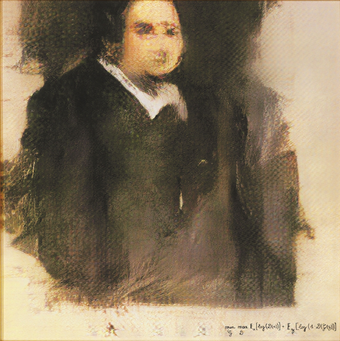Edmond de Belamy
 From HandWiki - Reading time: 3 min
From HandWiki - Reading time: 3 min
| Edmond de Belamy | |
|---|---|
 | |
| Artist | Obvious (collective) |
| Medium | Ink |
| Subject | Male portrait |
| Dimensions | 70 cm × 70 cm (27.5 in × 27.5 in) |
Edmond de Belamy is a generative adversarial network (GAN) portrait painting constructed in 2018 by Paris-based arts-collective Obvious.[1] Printed on canvas, the work belongs to a series of generative images called La Famille de Belamy. The name Belamy is a tribute to Ian Goodfellow, inventor of GANs; In French "bel ami" means "good friend" so it is a translated pun of Goodfellow.[2] It achieved widespread notoriety after Christie's announced its intention to auction the piece as the first artwork created using artificial intelligence to be featured in a Christie's auction. It surpassed pre-auction estimates which valued it at $7,000 to $10,000, instead selling for $432,500.[3][4]
The piece is a portrait of a somewhat-blurry man. It is a print on canvas measuring 27 1⁄2 x 27 1⁄2 in (700 x 700 mm.) set within a gilded wood frame. The image was created by an algorithm that referenced 15,000 portraits from various periods.
It is signed at the bottom right with [math]\displaystyle{ \min_{\mathcal{G}}\max_{\mathcal{D}}E_{x}\left[\log(\mathcal{D}(x))\right]+E_{z}\left[\log(1-\mathcal{D}(\mathcal{G}(z)))\right] }[/math], which is part of the algorithm code that produced it. The algorithm was trained on a set of 15,000 portraits from online art encyclopedia WikiArt, spanning the 14th to the 19th century.[5]
The organization that produced it is called Obvious. It is a collective comprising three people, Pierre Fautrel, Hugo Caselles-Dupré and Gauthier Vernier, who are based in Paris, France.
The piece has been criticized because it was created using a generative adversarial network (GAN) software package based on prior research by others and implemented by Robbie Barrat, an AI artist who was not affiliated with Obvious, leading to allegations that Obvious contributed minimally to the final work product. Posts on the project's issue tracker show Obvious members requesting that Barrat provide support and custom features.[6]
The piece has also been placed within a tradition, dating back to Duchamp's Bicycle Wheel of 1913 and Tinguely's Méta-matics of the late 1950s, of works calling into question the basis of the modern art market, and highlighting the comic aspects of technology.[7]
Research has used Edmond de Belamy to show how anthropomorphizing AI can affect allocations of responsibility and credit to artists.[8][9]
References
- ↑ "AI-produced artwork sells for $433K, smashing expectations - CNN Style". 2018-10-25. https://edition.cnn.com/style/article/obvious-ai-art-christies-auction-smart-creativity/index.html. Retrieved 2018-10-28.
- ↑ "How three French students used borrowed code to put the first AI portrait in Christie's". The Verge. 23 October 2018. https://www.theverge.com/2018/10/23/18013190/ai-art-portrait-auction-christies-belamy-obvious-robbie-barrat-gans.
- ↑ "Edmond de Belamy, from La Famille de Belamy". https://www.christies.com/Lotfinder/lot_details.aspx?sid=&intObjectID=6166184&T=Lot&language=en. Retrieved 29 October 2018.
- ↑ Cohn, Gabe (2018-10-25). "AI Art at Christie's Sells for $432,500". The New York Times. https://www.nytimes.com/2018/10/25/arts/design/ai-art-sold-christies.html. Retrieved 29 October 2018.
- ↑ "How an Art Collective is Using Artificial Intelligence to Make Paintings". 20 August 2018. https://time.com/5357221/obvious-artificial-intelligence-art/.
- ↑ "How three French students used borrowed code to put the first AI portrait in Christie's". The Verge. 23 October 2018. https://www.theverge.com/2018/10/23/18013190/ai-art-portrait-auction-christies-belamy-obvious-robbie-barrat-gans.
- ↑ Rolez, Anaïs (21 December 2018). "The Mechanical Art of Laughter". Arts 8: 2. doi:10.3390/arts8010002.
- ↑ Epstein, Ziv; Levine, Sydney; Rand, David G.; Rahwan, Iyad (25 September 2020). "Who Gets Credit for AI-Generated Art?". iScience (Cell) 23 (9): 101515. doi:10.1016/j.isci.2020.101515. PMID 32920489. Bibcode: 2020iSci...23j1515E.
- ↑ "People's notions about AI are terrible, an MIT study asks whether they can be helped". ZDNet. 18 September 2020. https://www.zdnet.com/article/peoples-notions-about-ai-are-terrible-an-mit-study-asks-whether-they-can-be-helped/.
Further reading
- Flynn, Meagan (26 October 2018). "A 19-year-old developed the code for the AI portrait that sold for $432,000 at Christie's". The Washington Post. https://www.washingtonpost.com/nation/2018/10/26/year-old-developed-code-ai-portrait-that-sold-christies/.
- "The first piece of AI-generated art to come to auction". Christie's. 9 August 2018. https://www.christies.com/features/A-collaboration-between-two-artists-one-human-one-a-machine-9332-1.aspx.
 |
 KSF
KSF